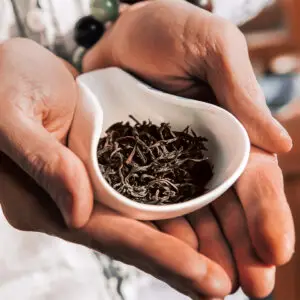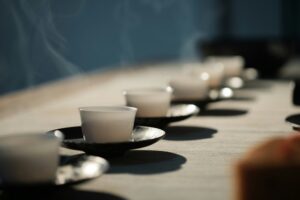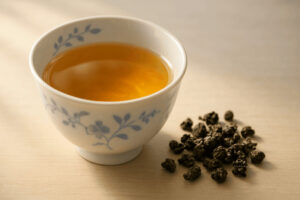Ever found yourself gazing at a beautifully arranged tea tray, perhaps in a specialty tea shop or on a friend’s Instagram, and spotted a tiny, whimsical figurine perched amongst the teaware? Chances are, you’ve encountered a tea pet (茶宠 – cháchǒng)! These charming little companions are more than just cute decorations; they’re a delightful part of tea culture, steeped in tradition, symbolism, and a touch of playful superstition.
So, grab your favorite cuppa, settle in, and let’s dive into the enchanting world of these miniature marvels. Who knows, you might just find yourself wanting one for your own tea rituals!
What in the Clay is a Tea Pet?
At its simplest, a tea pet is a small clay figurine made to accompany you during your tea sessions. Think of them as the silent, stoic (or sometimes cheeky!) observers of your tea journey. Traditionally, many prized tea pets are crafted from the same “purple clay” (Zisha – 紫砂) as the famous Yixing teapots from Jiangsu province in China, renowned for its unique properties. However, you can also find tea pets made from various other types of clay, and sometimes even materials like porcelain or resin.
They come in a delightful array of shapes and sizes – from auspicious animals like dragons and the three-legged money toad, to serene Buddhas and playful children. The idea is that by “feeding” your tea pet with leftover tea over time, it will gradually absorb the tea’s essence, developing a rich, glossy patina and a deeper color. It’s a slow, patient process, much like brewing a perfect cup of tea itself.
A Sip of History: Where Did These Little Critters Come From?
The exact origins of tea pets are a little misty, like the steam rising from a freshly brewed pot. However, their story is intrinsically linked to the development of Yixing clay teaware, which gained prominence during the Ming Dynasty (1368-1644) and truly flourished in the Qing Dynasty (1644-1912).
It’s believed that artisans, already skilled in crafting exquisite Zisha teapots prized for their ability to enhance the flavor of tea, began using leftover scraps of this precious clay to create small, whimsical figures. Initially, these might have been simple playthings or decorative accents. Some stories even suggest that early clay items, perhaps precursors to tea pets, were used to test the temperature of the water – if the figure changed color or texture rapidly when doused, the water was just right. While this practical application is debated, it adds a charming layer to their lore.

What’s certain is that by the Qing Dynasty, tea pets had become an established part of the Gongfu Cha (功夫茶) ceremony – the meticulous and artful Chinese tea preparation. They weren’t just ornaments; they were participants, adding a touch of personality and good fortune to the ritual.
The “Life” of a Tea Pet: Nourishing Your Clay Companion
This is where the magic truly happens! The “life” of a tea pet unfolds as you share your tea with it. After each tea session, instead of discarding the last few drops or the rinse, you pour it over your little friend. Because they are typically unglazed, the porous clay slowly absorbs the tea.
- The Transformation: Over weeks, months, and even years, this daily “nourishment” will cause the tea pet to:
- Develop a beautiful, subtle sheen or gloss.
- Deepen in color, taking on the hues of the teas you most frequently enjoy.
- Sometimes, even emit a faint, lingering aroma of tea.
This transformation is a visual representation of your tea journey and the time spent in quiet contemplation or shared conversation over countless cups. It’s said that a well-loved, well-nourished tea pet can even bring good luck and prosperity to its owner. The key is patience and consistency – and using only tea. Soaps or detergents are a definite no-no, as they can damage the clay and ruin the developing patina.
A Menagerie of Charm: Popular Types and Their Meanings
The variety of tea pets is vast, but some designs are particularly popular, often carrying symbolic meanings:
- Fish (Yu – 鱼): The word for fish sounds like the word for “abundance” or “surplus,” making them popular symbols of prosperity.
- The Three-Legged Money Toad (Jin Chan – 金蟾): Almost always depicted with a coin in its mouth, this creature is a powerful symbol of wealth and prosperity. Legend has it that it lures riches to your home.
- The “Peeing Boy” (尿童 – Niào Tóng): Perhaps the most amusing tea pet! This little fellow has a hidden trick, cleverly utilizing thermal expansion. When doused with hot water after being filled with cold water (or vice versa, through a small hole), he “pees” a stream of water – a playful nod, perhaps, to those early legends of using clay figures to gauge water temperature, and always good for a chuckle.
- Pixiu (貔貅): A mythical winged lion, the Pixiu is a fierce protector believed to ward off evil spirits and attract wealth (it’s said to have an appetite for gold and silver but no anus, so the wealth stays!).
- Zodiac Animals: Representing the twelve animals of the Chinese zodiac, these are personal and often chosen based on one’s birth year.
- Laughing Buddha (Budai – 布袋): A symbol of happiness, contentment, and abundance. Rubbing his belly is said to bring good luck.
- Dragons and Phoenixes: Powerful symbols of imperial power, good fortune, and harmony.
Why Invite a Tea Pet to Your Tea Table?
Beyond the historical and symbolic aspects, why welcome one of these clay companions into your modern tea life?
- A Touch of Whimsy and Personality: Let’s be honest, they’re cute! They add a focal point and a spark of individuality to your tea setup.
- Enhancing the Ritual: The act of pouring tea over your pet becomes a mindful part of your tea ceremony, a small, deliberate gesture that can be surprisingly grounding.
- A Tangible Connection to Tradition: Owning and nurturing a tea pet connects you to a centuries-old practice, enriching your appreciation for tea culture.
- A Story in the Making: Watching your tea pet slowly change and develop its unique patina is like watching a story unfold – your tea story. This journey of appreciation mirrors how one develops a palate for fine teas. Initially, the general comfort of a warm cup might suffice. With time, however, you might begin to discern the malty notes of a robust black tea or the grassy freshness of a Sencha. You might even find yourself unraveling the astonishingly complex, evolving aromas of a single-grove oolong. Consider Fenghuang Dancong, for example; this tea is celebrated for its ability to mimic a whole symphony of natural scents – from honey-orchid and almond to osmanthus or even ginger flower – all depending on the specific grove and processing. This deepening appreciation for nuance, whether in a cup of rare oolong or the character of your tea pet, is a truly rewarding experience.
- Conversation Starter: Guests will undoubtedly be curious about your little friend, opening up opportunities to share your love for tea and its traditions.
Choosing and Caring for Your Clay Friend
If you’re tempted to get a tea pet, choose one that genuinely appeals to you – one that makes you smile or feel a sense of connection. It could be its expression, its symbolism, or simply its charming presence.
- Material Matters: While Yixing Zisha clay is traditional and highly prized for its porous nature, you’ll find lovely tea pets made from various types of clay. The material will influence how it absorbs tea and develops its patina.
- Nourish with Love (and Tea!): As mentioned, only “feed” your pet with tea. Any type of tea will do – green, black, oolong, pu-erh. Many enthusiasts dedicate a pet to a specific type of tea to see how its unique characteristics influence the patina.
- Patience is a Virtue: Don’t expect dramatic changes overnight. The beauty of a tea pet lies in its slow, gradual transformation.
A Tiny Companion for Big Tea Moments
Tea pets are more than just inanimate objects; they become part of your tea narrative. They witness your quiet morning reflections, your lively conversations with friends, and your moments of solitary peace. They are a small, tangible reminder of the joy, tradition, and artistry that tea brings into our lives.
So, next time you’re brewing a pot, consider if there’s a little space on your tea tray for a charming clay companion. It might just make your tea experience even richer.




